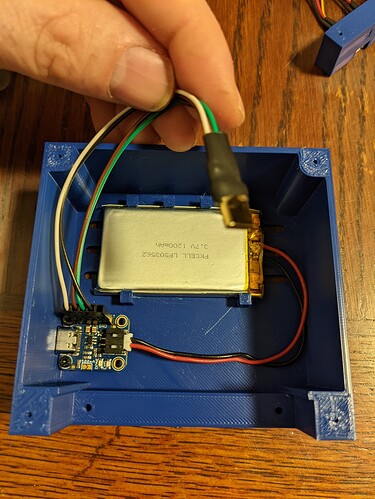I have a Tiny 2040 running Micropython. I have the board connected to a few sensors (3 capacitive moisture sensors, I2C 128x64 OLED, MQ135 Air Quality Sensor, and a DHT22 Humidity and Temperature Sensor) and running off a 3.7V 1200mAh LIPO battery. It seems after a day my battery is dead but I have it running continually and would like to put it into a deep sleep after a button press so the battery lasts longer than a day! I don’t need it to run constantly I just need it to run when I want to look at OLED. What can I change in the code to achieve this? Please give me an example… Thanks!
# Load Libraries--------------------------------
import machine, time, random
from machine import I2C, Pin, ADC
from dht22 import DHT22 # Temperature & Humidity Sensor module
from sh1106 import SH1106_I2C # I2C Serial 128x64 SSH1106 OLED Display Module
from csms import CSMS # Calculates Hi/Low values sensor values module
from mq135 import MQ135 # Gas/CO2 sensor module
# Define/Initialize GPIO Pins--------------------
i2c2 = I2C(0, sda=machine.Pin(0), scl=machine.Pin(1), freq=400000)
dht22 = DHT22(machine.Pin(2,machine.Pin.IN,machine.Pin.PULL_UP))
adc0 = machine.ADC(machine.Pin(26)) # Moisture sensor 1
adc1 = machine.ADC(machine.Pin(27)) # Moisture sensor 2
adc2 = machine.ADC(machine.Pin(28)) # Moisture sensor 3
adc3 = MQ135(29) # Gas sensor 4
# OLED Display-----------------------------------
oled_width = 128 # Width of OLED screen
oled_height = 64 # Height of OLED screen
oled = SH1106_I2C(oled_width, oled_height, i2c2)
# Scroll in OLED screen vertically---------------
def scroll_in_screen_v(screen):
for i in range (0, (oled_height+1), 1):
for line in screen:
oled.text(line[2], line[0], -oled_height+i+line[1])
oled.show()
if i!= oled_height:
oled.fill(0)
# Scroll out OLED screen vertically--------------
def scroll_out_screen_v(speed):
for i in range ((oled_height+1)/speed):
for j in range (oled_width):
oled.pixel(j, i, 0)
oled.scroll(0,speed)
oled.show()
# CSMS ADS moisture Hi/Low values----------------
csms0 = CSMS(adc0, min_value=54967, max_value=29563) # old: min_value=60000, max_value=24854
csms1 = CSMS(adc1, min_value=54967, max_value=29563) # old: min_value=60000, max_value=24854
csms2 = CSMS(adc2, min_value=54967, max_value=29563) # old: min_value=60000, max_value=24854
# Variable-------------------------------------------
i = 0
while True:
# Create a .csv file-------------------------
filename = ("data" + str(random.getrandbits(16)) + ".csv") # Log given a random name to minimise risk of overwriting data upon power loss
file = open(filename, "w")
file.close()
# Begin Loop---------------------------------------------------------------------------------------
while True:
# Empty cache and assess memory strain---
csvdata = []
with open(filename,'r') as file:
for line in file:
csvdata.append(line.rstrip('\n').rstrip('\r').split(','))
if len(csvdata) > 300:
break
# Update Temperature & Humidity Sensor---
T, H = dht22.read() # Gets Temp & Hum from dht22.py library
temp_f = T * (9/5) + 32.0 # Converts the (T) temperature to Fahrenheit degrees
# Update Gas/CO2 sensor------------------
rzero = adc3.get_rzero()
corrected_rzero = adc3.get_corrected_rzero(T, H)
resistance = adc3.get_resistance()
ppm = adc3.get_ppm()
corrected_ppm = adc3.get_corrected_ppm(T, H)
# Iterate lognum-------------------------
i += 1
if len(str(i)) == 1:
lognum = ("Log0000" + str(i))
elif len(str(i)) == 2:
lognum = ("Log000" + str(i))
elif len(str(i)) == 3:
lognum = ("Log00" + str(i))
elif len(str(i)) == 4:
lognum = ("Log0" + str(i))
else:
lognum = ("Log" + str(i))
# Get Min/Max values---------------------
sm1set = [x[4] for x in csvdata]
sm2set = [x[5] for x in csvdata]
sm3set = [x[6] for x in csvdata]
csvdata = []
if sm1set ==[]:
row3 = "High " + "N/A" + " " + "N/A" + " " + "N/A"
row5 = "Low " + "N/A" + " " + "N/A" + " " + "N/A"
else:
row3 = "High " + max(sm1set) + " " + max(sm2set) + " " + max(sm3set)
row5 = "Low " + min(sm1set) + " " + min(sm2set) + " " + min(sm3set)
sm1set = []
sm2set = []
sm3set = []
# Update capacitive sensors using CSMS---
soilz1 = csms0.read(25)
soilz2 = csms1.read(25)
soilz3 = csms2.read(25)
if len(str(soilz1)) == 1: # Normalises the length of the values
soil1 = ("0" + str(soilz1) + "%")
elif len(str(soilz1)) == 2:
soil1 = (str(soilz1) + "%")
else:
soil1 = ("Max")
if len(str(soilz2)) == 1: # Normalises the length of the values
soil2 = ("0" + str(soilz2) + "%")
elif len(str(soilz2)) == 2:
soil2 = (str(soilz2) + "%")
else:
soil2 = ("Max")
if len(str(soilz3)) == 1: # Normalises the length of the values
soil3 = ("0" + str(soilz3) + "%")
elif len(str(soilz1)) == 2:
soil3 = (str(soilz3) + "%")
else:
soil3 = ("Max")
# Write to OLED screen-------------------
# %m.kf Converts a value of type float (or double) to m decimal positions with k digits after the period.
OLED_screen1 = [[0, 21 , "Temp: %3.0fF" %temp_f], [0, 37, "Humidity: %3.0f%%" %H]]
OLED_screen2 = [[0, 8, "SNSR 1 2 3"],
[1, 12, "____________________"],
[0, 29, (row3)],
[0, 42, "Now " + str(soil1) + " " + str(soil2) + " " + str(soil3)],
[0, 55, (row5)]]
OLED_screen3 = [[0, 8, "CO2 LEVEL"],
[1, 12, "____________________"],
[0, 29, str(corrected_ppm)+" ppm"]]
# Scroll in, stop, scroll out (vertical)
scroll_in_screen_v(OLED_screen1)
time.sleep(5) # Sleep for 5 seconds
scroll_out_screen_v(2)
scroll_in_screen_v(OLED_screen2)
time.sleep(5) # Sleep for 5 seconds
scroll_out_screen_v(2)
scroll_in_screen_v(OLED_screen3)
time.sleep(5) # Sleep for 5 seconds
scroll_out_screen_v(2)
oled.text('Saving Data...', 0, 25, 1)
# oled.line(9,35,120,35,1) # draw a line from 9,35 to 120,35 colour=1
oled.show()
# Write values to .csv file--------------
# %m.kf Converts a value of type float (or double) to m decimal positions with k digits after the period.
# time.time() is saved in Epoch Unix Timestamp
file = open(filename, "a+")
file.write(str(lognum) + "," + str(time.time()) + "," + str("%3.0fF" %temp_f) + "," + str("%3.0f%%" %H) + "," + str(soil1) + "," + str(soil2) + "," + str(soil3) + "\n")
file.close()
oled.fill(0) #Clear OLED for next loop
